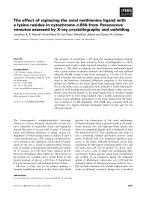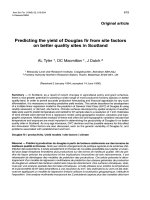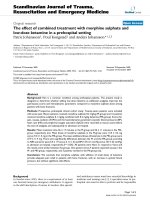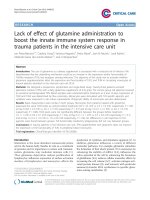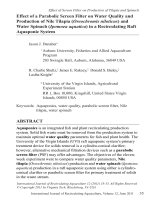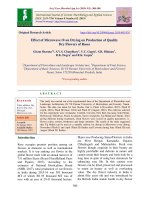Effect of non-genetic factors on semen quality traits of crossbred holstein friesian bulls (Bos taurus X Bos indicus) in organized farming conditions at Tamil Nadu, India
Bạn đang xem bản rút gọn của tài liệu. Xem và tải ngay bản đầy đủ của tài liệu tại đây (352.52 KB, 11 trang )
Int.J.Curr.Microbiol.App.Sci (2018) 7(11): 3219-3229
International Journal of Current Microbiology and Applied Sciences
ISSN: 2319-7706 Volume 7 Number 11 (2018)
Journal homepage:
Original Research Article
/>
Effect of Non-genetic Factors on Semen Quality Traits of
Crossbred Holstein Friesian Bulls (Bos taurus X Bos indicus) in
Organized Farming Conditions at Tamil Nadu, India
A. Gopinathan1*, S.N. Sivaselvam1, S.M.K. Karthickeyan1, K. Kulasekar2,
J. John Kirubaharan3 and R. Venkataramanan4
1
Department of Animal Genetics and Breeding, 2Department of Veterinary Obstetrics and
Gynaecology, 3Department of Veterinary Microbiology, Madras Veterinary College, India
4
Post-Graduate Research in Animal Sciences, Kattupakkam, Tamil Nadu Veterinary and
Animal Sciences University, Tamil Nadu, India
*Corresponding author
ABSTRACT
Keywords
CBHF bulls, Semen
production, Nongenetic factors and
semen quality
parameters
Article Info
Accepted:
26 October 2018
Available Online:
10 November 2018
The objective of the study was to assess the effects of non-genetic factors such as farm,
order of ejaculate, period, season of collection and age of the bull on semen quality traits
of crossbred Holstein Friesian (CBHF) bulls. Data on a total of 22442 ejaculates from 72
CBHF bulls collected during the period from 1996 to 2014 were obtained from three
organized farms in Tamil Nadu, India. The overall least-squares means for semen volume
(SV), sperm concentration (SC), mass activity (MA), initial sperm motility (ISM), postthaw motility (PTM) and number of doses per ejaculate were 4.53 ± 0.05 ml, 1081.33 ±
15.59 millions per ml, 2.54 ± 0.02, 70.00 ± 0.00 per cent, 52.48 ± 0.00 per cent and 221.82
± 1.54 doses respectively. The fixed effects such as farm, period and age of the bull; and
interaction of fixed effects of farm x season and age x season were highly significant
(P<0.01) for all the semen quality traits. The order of ejaculate was highly significant
(P<0.01) on PTM and number of doses per ejaculate. SC and ISM were significantly
(P<0.01) higher during winter season. Based on the results, it could be concluded that
farm I, first ejaculate, period-IV, winter season and 118 to 142 months of age, the CBHF
bull produced comparatively best quality of semen.
Introduction
In India, cross breeding is practiced to
improve cattle productivity by crossing the
indigenous cattle (Bos indicus) with temperate
(Bos taurus) breeds. In 1891, the
crossbreeding was first started in dairy farms
of British Indian Army with exotic cattle
breeds such as Jersey, Holstein Friesian (HF)
and Brown Swiss to improve native cattle
breeds of Sahiwal, Hariana, Tharparkar,
Sindhi, Gir and non-descript cattle population,
since then the population of exotic and their
crossbred cattle in India has been increasing.
3219
Int.J.Curr.Microbiol.App.Sci (2018) 7(11): 3219-3229
As per the 19th Livestock Census (2012), the
total number of cattle in the country is 190.90
million. The exotic/crossbred cattle population
increased from 14.40 million in 2007 to 19.42
million in 2012, giving rise to an increase of
34.78 per cent whereas the indigenous cattle
increased marginally from 48.04 to 48.12
million, an increase of 0.17 per cent only. The
share of Tamil Nadu to the total cattle
population in the country is 4.61 per cent (8.8
million) with the exotic/crossbred and
indigenous breeds of 5.4 and 1.7 million
respectively. Among exotic breeds, Jersey and
Holstein Friesian (HF) have been found to be
more suitable for crossbreeding in Tamil
Nadu. The increase in number of
exotic/crossbred cows necessitated the huge
demand of quality frozen semen of purebred
and crossbred bulls over the years. The semen
quality parameters were influenced by breed
(Mukhopadhyay et al., 2010); environment
(Mandal et al., 2008) and age of the bull
(Mandal et al., 2010), but these factors are not
reliable as their effects differ from one
environment to another, which makes
assessment of semen production difficult.
Therefore, all the frozen semen stations in
India are following a protocol for Minimum
Standard for Production (MSP, 2012) of
bovine frozen semen, which reduces the
variable management and semen processing
conditions and improves the quality of frozen
semen. Hence, more emphasis needs to be
given for continuous supply of frozen semen
from CBHF bulls in required areas of the
state. But, there is inadequate information on
the performance of CBHF bulls even though
such crossbred bulls are being used for
decades for production of frozen semen in
Tamil Nadu. Therefore, the present study was
designed to investigate the effect of various
non-genetic factors on semen quality traits in
CBHF bulls. This study is first of its kind in
southern India, with respect to HF inheritance,
since HF bulls were predominately used in
northern India.
Materials and Methods
Farms
Evaluation of semen quality traits was carried
out in three farms situated in Tamil Nadu,
such as
(i) District Livestock Farm
(ii) Nucleus Jersey and Stud Farm, both
situated in 11⁰ 24’N and 76⁰ 42’E with an
altitude of 2460 to 2662 metres above mean
sea level (MSL)
(iii)
Exotic
Cattle
Breeding
Farm,
Eachenkottai situated in 10⁰ 45’N and
79⁰ 29’E with an altitude of 50 metres above
MSL.
Data collection and structure
From these three farms, data on a total of
22442 ejaculates from 72 CBHF bulls
collected during the period from 1996 to 2014
were obtained.
The semen production data comprising of bull
number, date of birth, date of semen
collection, order of ejaculation, semen volume
(SV), sperm concentration (SC), mass activity
(MA), initial sperm motility (ISM), post-thaw
sperm motility (PTM) and number of doses
per ejaculate were collected.
Classification of data
The data were analyzed to study the effects of
farms (I, II and III), order of ejaculate (I and
II), periods (period I-1996 to 1998, II-1999 to
2001, III-2002 to 2004, IV-2005 to 2007, V2008 to 2010 and VI- 2011 to 2014), seasons
[winter (December, January and February),
summer (March, April and May), southwest
monsoon (June, July and August) and
northeast monsoon (September, October and
November)] and age of the bulls (age group I18 to 42 months, II-43 to 67 months, III-68 to
92 months, IV-93 to 117 months, V-118 to
3220
Int.J.Curr.Microbiol.App.Sci (2018) 7(11): 3219-3229
142 months and VI-more than 143 months).
Analysis of semen quality traits
traits are given in Tables 1 and 2 respectively.
Semen volume (SV)
To evaluate the effect of non-genetic factors
on semen quality traits, the following model
was fitted using the univariate analyses under
general linear model of Statistical Package
Software (SPSS Version 17; SPSS Inc.
Chicago, IL).
The overall least-squares mean for semen
volume was 4.53 ± 0.05 ml, which was
significantly (P<0.01) influenced by the fixed
effects viz. farm, period and age of the bull;
and interaction effects of
farm x season;
age x season and age x ejaculate. Of the three
farms, farms I and II recorded the highest SV
(4.61 ± 0.06 ml). SV was found be
significantly more in period III (2002 - 2004)
when compared to other periods which might
be due to selection of superior bull calves in
previous periods and improved management
apart from the other environmental factors.
The SV increased proportionately as the age
advanced (3.34 ml to 5.81 ml). Even at the age
of 12 years, the bulls were able to give the
highest volume of semen. Quite interestingly,
the season did not influence the SV. It is the
general perception that animals with HF
inheritance would perform better only at
cooler climate and high altitude in India. But
this age-old perception is proved wrong now
in understanding that the CBHF bulls would
perform equally well, even in the plains if the
management is good. This explanation is also
supported by significant farm x season
interaction. The SV was not affected by winter
and summer seasons in all the three farms,
because of better summer management in farm
I (plain region) and better winter management
in farms II and III (hilly region).
Yijklmo ` =
µ + Fi + Ej + Pk + Sl + Am +
(FSi)il + (ES)jl + (AS)ml + (AE)mj + eijklmo
Where, Yijklmo is the semen quality trait of oth
observation belonging to
ith
farm, jth ejaculate, kth period, lth season and mth
age effects. µ is the overall mean; Fi is the
fixed effect of the ith farm (i=1 to 3). Ej is the
fixed effect of jth ejaculate (j=1 and 2); Pk is
the fixed effect of kth period (k=1 to 6). Sl is
the fixed effect of lth season (l= 1 to 4) and Am
is the fixed effect of mth age of the bull (m=1
to 6). (FS)il is the interaction of fixed effects
between ith farm and lth season; (ES)jl is the
interaction of fixed effects between jth
ejaculate and lth season; (AS)ml is the
interaction of fixed effects between mth age
and lth season; (AE)mj is the interaction of fixed
effects between mth age and jth ejaculate and
eijklmo is a random residual effect.
The differences between the least-squares
means for sub-classes under a particular effect
were tested by using Scheffe test (1959) for
their significance. The semen quality traits (in
percentages) such as ISM and PTM were
adjusted after angular transformation of the
percentages as per Snedecor and Cochran
(1987).
Results and Discussion
Semen quality traits
The least-squares means and the least-squares
ANOVA (mean squares) for semen quality
Perusal of available literature revealed higher
SV of 6.22 ml (Haque et al., 2001), 4.70 ml
(Andrabi et al., 2002), 5.62 ml (Haq et al.,
2003), 4.60 ml (Sugulle et al., 2006), 6.40 ml
(Shaha et al., 2008), 4.73 ml (Mukhopadhyay
et al., 2010), 4.60 ml (Mandal et al., 2012),
6.68 ml (Patel et al., 2012), 5.80 ml (Khatun et
al., 2013) and 5.60 ml (Srivastava and Kumar.
2014) in CBHF bulls. Some authors had
reported lower SV of 4.06 ml (Mathur et al.,
2002), 4.01 ml (Nasrin et al., 2008) and 3.59
3221
Int.J.Curr.Microbiol.App.Sci (2018) 7(11): 3219-3229
ml (Mandal and Tyagi. 2009). The wider
differences in SV reported for CBHF bulls in
India and other neighbouring countries could
be due to the type of indigenous breed or zebu
cattle used for crossing with HF and to some
extent the differences in bull managment.
Period effect was found to be significant on
SV (Bhakat et al., 2009; Chauhan et al., 2010;
Khatun et al., 2013). Many authors reported
that season of collection significantly
influenced the SV (Andrabi et al., 2002; Asad
et al., 2004; Mandal et al., 2008) with
favoured season being winter. Whereas the SV
was not affected by the season as found in the
present study (Sarder et al., 2000; Mathur et
al., 2002 and Sarder, 2007). In consonance
with the present observation, the SV was
reported to have increased as the age of the
bulls advanced (Sudheer, 2000; Asad et al.,
2004; Jain et al., 2008 and Mandal et al.,
2010) in CBHF bulls.
Sperm concentration (SC)
The least-squares mean SC was 1081.33 ±
15.59 million per ml and this trait was affected
significantly (P<0.01) by the farm, period,
season and age of the bull. The interaction
effects of farm x season, age x season and age
x ejaculate were significant on SC while
ejaculate x season was not significant. The
highest SC was seen in farm I even though the
mean semen volume was also high. The first
ejaculate had a higher SC (1137.96 ± 21.30)
than the second ejaculate (1024.69 ± 21.92)
but did not differ significantly. Highest SC
was noticed in period IV (1295.79 ± 18.53)
and winter season (1103.59 ± 12.63). The
highest SC was observed during 43 to 67
months of age (1183.37 ± 7.56) after that it
decreased as age advanced and showed
negative correlation with SV.
Earlier workers reported both higher SC
(Mathur et al., 2002; Sugulle et al., 2006;
Sarder. 2007; Mandal et al., 2008; Patel et al.,
2012 and Akhter et al., 2013) and lower SC
(Haque et al., 2001; Nasrin et al., 2008;
Kumar and Srivastava. 2008; Mandal and
Tyagi. 2009 and Srivastava and Kumar. 2014)
in CBHF bulls than that obtained in the
present study. Period effect was found to be
significant on SC (Bhakat et al., 2009;
Chauhan et al., 2010 and Khatun et al., 2013).
Similarly season had significantly influenced
the SC (Andrabi et al., 2002; Asad et al.,
2004; Sarder. 2007 and Shaha et al., 2008).
However, the SC was reported to increase
with the age of the bulls (Asad et al., 2004 and
Mandal et al., 2010). On the contrary, there
are few reports on age of the bull not affecting
the sperm concentration in CBHF bulls
(Sudheer. 2000 and Jain et al., 2008).
Mass activity (MA)
The least-squares mean mass activity was 2.54
± 0.02 and it was influenced significantly
(P<0.01) by the farm, period and age of the
bull, but not by the ejaculate and season. The
interaction effects of farm x season and age x
season were highly significant (P<0.01) on
MA while age x ejaculate interaction was
significant (P<0.05) and ejaculate x season did
not influence this trait. The wider variation in
MA values across the farms and periods could
be attributed to different personnel who
processed the semen over the period of 19
years and the MA is a subjective assessment
which is bound to vary from person to person.
The higher value of MA is the result of higher
SC in the first ejaculate than in the second
ejaculate. The MA score increased nonsignificantly from 18 to 42 months of age
(2.51) to 68 to 92 months (2.56), it peaked
from 93 to 117 months of age (2.78) and
started decreasing significantly.
Higher MA scores of 2.94 (Mathur et al.,
2002), 3.30 (Sugulle et al., 2006), 2.91
(Sarder. 2007), 3.06 (Kumar and Srivastava.
3222
Int.J.Curr.Microbiol.App.Sci (2018) 7(11): 3219-3229
2008), 3.25 (Mukhopadhyay et al., 2010), 2.83
(Patel et al., 2012) and 3.00 (Srivastava and
Kumar, 2014) were reported by earlier
workers. On the other hand, lower MA scores
of 2.49 (Haque et al., 2001), 1.25 (Haq et al.,
2003) and 1.47 (Mandal and Tyagi, 2009)
were also reported in CBHF bulls. The present
study is in agreement with reports of earlier
workers on period effect (Bhakat et al., 2009;
Chauhan et al., 2010 and Khatun et al., 2013)
and age of the bull (Asad et al., 2004 and
Mandal et al., 2010) significantly on MA.
Non-significant effect of season on MA found
in the present study corroborates with the
report of Mathur et al., (2002) in CBHF bulls.
Initial sperm motility (ISM)
The least-squares analysis brought out an
overall mean of 70.00 ± 0.00 per cent of ISM
in CBHF bulls. This trait was also affected by
farm, period, season and age of the bull
significantly (P<0.01). All the interaction
effects except ejaculate x season significantly
(P<0.01) influenced the ISM. Like MA, ISM
is also a subjective assessment; it differs
significantly between the farms and different
periods under the study. The winter season
(70.97 ± 0.00) produced the highest ISM when
compared to other seasons. The second
ejaculate had higher ISM (72.43) than the first
ejaculate (67.49) due to aging of sperms,
which is lesser in second ejaculate when
compared to first. An increasing trend of ISM
was observed between the bulls of age group
from 18 to 117 months of age (65.70 to
72.68), and then it attains significantly highest
ISM per cent (75.53) at 118 to 142 months of
age.
There are only two reports (Patel et al., 2012
and Srivastava and Kumar. 2014) which
showed a higher ISM in CBHF bulls. All the
other reports showed a lower ISM than that
obtained in the present study (Haque et al.,
2001; Mathur et al., 2002; Haq et al., 2003;
Sugulle et al., 2006; Sarder. 2007; Kumar and
Srivastava, 2008; Nasrin et al., 2008; Mandal
and Tyagi, 2009; Mandal et al., 2012; Khatun
et al., 2013). The reports on effects of period,
season and age of the bull were sparse while
pursuing the literature survey with respect to
CBHF bulls.
Post-thaw motility (PTM)
The overall mean value for PTM was 52.48 ±
0.00 per cent. It was affected by the farm,
ejaculate, period and age of the bull
significantly (P<0.01) but not by the season.
Interaction of fixed effects such as farm x
season and age x season had significant
(p<0.01) effect on PTM. Farm I had the
highest PTM followed by farm III and farm II.
The second ejaculate had higher PTM than the
first ejaculate. Period V showed PTM values
of 56.07 per cent which was significantly
higher when compared to other periods except
period VI. The increasing trend of ISM and
corresponding decreasing trend of PTM over
the age groups of CBHF bulls exhibited the
reduced sperm motility after exposure to
freezing. But, the per cent reduction of sperm
motility was more from 93 to >143 months of
age. It indicated that up to 7.5 years of age, the
sperms withstand the process of freezing as
the PTM reduces thereafter. Sperms produced
by the aged bulls might have impaired
membrane integrity that leads to freezing
injury and reduction of PTM.
All the available reports revealed that the
lower PTM (Kumar and Srivastava, 2008;
Mandal and Tyagi, 2009; Mandal et al., 2012;
Srivastava and Kumar. 2014) than the present
study. The only report (Sarder, 2007) showed
higher PTM of 55.09 per cent, when compared
to present study.
The overall higher PTM recorded in the
present study might be due to genetic merit of
selected bulls and better processing
conditions.
3223
Int.J.Curr.Microbiol.App.Sci (2018) 7(11): 3219-3229
Table.1 Least-squares means along with standard error for semen quality traits
Effects
SV
(ml)
SC
(millions per ml)
MA
(0 to 5 scale)
ISM
(per cent)
PTM
(per cent)
No. of doses per
ejaculate
4.53 ± 0.05
(22442)
1081.33 ± 15.59
(22442)
2.54 ± 0.02
(22442)
70.00 ± 0.00
(22442)
52.48 ± 0.00
(20242)
221.82 ± 1.54
(19478)
Farm
**
**
**
**
**
**
I
a
b
b
a
Overall
4.61 ± 0.06
(3697)
a
1129.32 ± 18.31
(3697)
2.58 ± 0.02
(3697)
74.71 ± 0.00
(3697)
59.31 ± 0.00
(3600)
261.60a ± 2.51
(3592)
II
4.61a ± 0.06
(14182)
1109.97b ± 16.41
(14182)
3.20a ± 0.02
(14182)
77.91a ± 0.00
(14182)
47.85c ± 0.00
(13390)
188.63b ± 1.91
(12635)
III
4.38b ± 0.06
(4563)
1004.70c ± 16.09
(4563)
1.85c ± 0.02
(4563)
56.23c ± 0.00
(4563)
50.21b± 0.00
(3252)
215.23a± 1.95
(3251)
NS
NS
NS
NS
**
**
I
4.53 ± 0.07
(13470)
1137.96 ± 21.30
(13470)
2.60 ± 0.02
(13470)
67.49 ± 0.00
(13470)
52.09 ± 0.00
(12117)
238.69 ± 1.90
(11649)
II
4.54 ± 0.07
(8972)
1024.69 ± 21.92
(8972)
2.49 ± 0.02
(8972)
72.43 ± 0.00
(8972)
52.86 ± 0.00
(8125)
204.95 ± 2.06
(7829)
Period
I (1996 - 1998)
**
4.42c ± 0.07
(1048)
4.26e ± 0.06
(7663)
4.87a ± 0.05
(6315)
4.61b ± 0.06
(2074)
**
941.20d ± 21.82
(1048)
1039.76c ± 16.38
(7663)
1099.67bc ± 16.25
(6315)
1295.79a ± 18.53
(2074)
**
2.23d ± 0.02
(1048)
2.33c ± 0.02
(7663)
2.48c ± 0.02
(6315)
2.61b ± 0.02
(2074)
**
65.98f ± 0.00
(1048)
73.98a ± 0.00
(7663)
72.71b ± 0.00
(6315)
68.23d ± 0.00
(2074)
**
45.40d ± 0.00
(977)
53.05b ± 0.00
(7265)
51.76c ± 0.00
(5922)
53.13b ± 0.00
(1703)
**
152.71d ± 3.87
(787)
152.24c ± 1.84
(7055)
203.68c ± 1.78
(5637)
306.23a ± 2.81
(1629)
Ejaculate
II (1999 - 2001)
III (2002 - 2004)
IV (2005 - 2007)
3224
Int.J.Curr.Microbiol.App.Sci (2018) 7(11): 3219-3229
Effects
SV
SC
MA
ISM
PTM
No. of doses per
(ml)
(millions per ml)
(0 to 5 scale)
(per cent)
(per cent)
ejaculate
4.34d ± 0.07
1162.32b ± 20.36
2.87a ± 0.02
72.66c ± 0.00
56.07a ± 0.00
276.64b ± 3.18
V (2008 - 2010)
(1605)
1605)
(1605)
(1605)
(1428)
(1425)
4.69b ± 0.06
949.23d ± 17.98
2.74b ± 0.02
66.13e ± 0.00
55.43a ± 0.00
239.42bc ± 2.49
VI (2011 - 2014)
(3737)
(3737)
(3737)
(3737)
(2947)
(2945)
NS
**
NS
**
NS
NS
Season
4.70 ± 0.04
1103.59a ± 12.63
2.57 ± 0.01
70.97a ± 0.00
52.59 ± 0.00
221.76 ± 2.72
Winter
(5734)
(5734)
(5734)
(5734)
(5292)
(5058)
4.71 ± 0.04
1048.27c ± 11.91
2.54 ± 0.01
70.86b ± 0.00
52.27 ± 0.00
217.00 ± 2.56
Summer
(5905)
(5905)
(5905)
(5905)
(5247)
(5027)
4.61 ± 0.04
1085.89ab ± 11.25
2.55 ± 0.01
69.53c ± 0.00
52.30 ± 0.00
223.66 ± 2.53
Southwest monsoon
(5939)
(5939)
(5939)
(5939)
(5249)
(5091)
4.18 ± 0.18
1086.67bc ± 51.44
2.52 ± 0.06
68.81d ± 0.02
52.72 ± 0.00
224.88 ± 2.95
Northeast monsoon
(4864)
(4864)
(4864)
(4864)
(4454)
(4302)
**
**
Age
**
**
**
**
3.34b ± 0.03
1067.59b ± 7.55
2.51b ± 0.01
65.70b ± 0.00
53.38a ± 0.00
162.44f ± 1.69
I (18 to 42 m)
(6749)
(6749)
(6749)
(6749)
(6113)
(5805)
4.27a ± 0.03
1183.37a ± 7.56
2.59b ± 0.01
66.98b ± 0.00
53.35a± 0.00
210.47d± 1.66
II (43 to 67 m)
(7633)
(7633)
(7633)
(7633)
(6920)
(6720)
4.54a ± 0.03
1151.15a ± 9.11
2.56b ± 0.01
66.04b ± 0.00
52.42a ± 0.00
223.02c ± 2.04
III (68 to 92 m)
(5274)
(5274)
(5274)
(5274)
(4693)
(4484)
4.73a ± 0.05
1096.03b ± 15.19
2.78a ± 0.02
72.68b ± 0.00
51.69b ± 0.00
247.46b ± 3.21
IV (93 to 117 m)
(1499)
(1499)
(1499)
(1499)
(1435)
(1389)
5.21a ± 0.07
1026.82c ± 21.21
2.59b ± 0.02
75.53a ± 0.00
52.23a ± 0.00
279.24a ± 4.56
V (118 to 142 m)
(693)
(693)
(693)
(693)
(622)
(621)
5.81a ± 0.08
953.41d ± 24.88
2.31c ± 0.03
74.94a ± 0.00
51.78b ± 0.00
208.30e ± 5.80
VI (>143 m)
(594)
(594)
(594)
(594)
(459)
(459)
** - Highly significant (P<0.01) and NS- Non-significant. Figures in parentheses indicate number of observations. Means with at least one common superscript within classes
do not differ significantly (P>0.05)
3225
Int.J.Curr.Microbiol.App.Sci (2018) 7(11): 3219-3229
Table.2 Least-squares ANOVA (mean squares) for semen quality traits
Source of
variation
SV
SC
MA
ISM
PTM
No. of doses per
ejaculate
df
MSS
df
MSS
df
MSS
df
MSS
df
MSS
df
MSS
Farm
2
65.27**
2
14627439.77**
2
2215.09**
2
203820.98**
2
45998.16**
2
5537303.44**
Order of
ejaculate
Period of
collection
Season of
collection
Age
1
0.22NS
1
140362.15NS
1
1.04NS
1
265.98NS
1
314.04**
1
1808744.20**
5
254.80 **
5
29041904.48**
5
134.63**
5
15360.67**
5
5960.17**
5
7464438.65**
3
6.87NS
3
976486.68**
3
0.50NS
3
337.43**
3
23.91NS
3
18941.49NS
5
973.57**
5
8671965.99**
5
15.71**
5
5726.38**
5
315.15**
5
2537911.69**
Farm x
season
Ejaculate x
season
Age x
season
Age x
ejaculate
Error
6
10.62**
6
836909.53**
6
5.36**
6
676.84**
6
92.82**
6
38869.61**
3
1.49NS
3
216828.92NS
3
0.82NS
3
161.05NS
3
9.85NS
3
14356.59NS
15
4.96**
15
840321.23**
15
2.58**
15
276.97**
15
69.94**
15
31482.15**
5
53.83**
5
1746656.25**
5
0.81*
5
2518.02**
5
21.94NS
5
57102.61**
22396
2.84
22396
243364.79
22396
0.30
22396
83.62
20196
17.57
19432
9934.57
** - Highly significant (P<0.01); *- Significant (P<0.05) and NS- Non-significant
3226
Int.J.Curr.Microbiol.App.Sci (2018) 7(11): 3219-3229
bulls, the results obtained in the present study
could not be compared.
Number of doses per ejaculate
The least-squares analysis produced a mean
of 221.82 ± 1.54 doses of frozen semen per
ejaculate. As seen in most of the other traits
of semen quality, this trait was also
significantly affected (P<0.01) by the farm,
ejaculate, period and age of the bull. The
effects of farm x season, age x season and age
x ejaculate interactions were significant on
the number of doses per ejaculate. Season of
semen collection did not affect the number of
doses produced per ejaculate.
Farm I produced the maximum of 261.60
doses per ejaculate followed by farm III
(215.23 doses) and farm II (188.63 doses),
since, number of doses per ejaculate depends
on SV, SC and ISM. Even though, both farms
II and III are in hilly regions, the variation of
semen quality traits could be directly due to
indigenous breed component in CBHF bulls
and indirectly due to sample size, forage
quality (plant – animal interaction) and source
of concentrate feed.
The first ejaculate (238.69 doses) produced
significantly more doses of frozen semen than
the second ejaculate (204.95 doses). The
highest number of doses (306.23 doses) per
ejaculate was produced during period IV was
reflected by highest SV, SC and ISM during
that period.
The number of doses increased from 162.44
(18 to 42 months of age) to 279.24 (118 to
142 months of age) and thereafter it decreased
significantly to 208.30 doses. In this study, it
is proved that in older age (>143 months), the
SV is increasing due to male accessory sex
glands, but the real sperm producing potential
of seminiferous tubules in the testes was
reduced as it was witnessed by lower SC and
in turn by lowest number of doses per
ejaculate. As there is scarcity of literature on
the number of doses per ejaculate in CBHF
It is concluded that from the findings of the
study farm, period and age of the bull and the
interaction effects of farm x season, age x
season and age x ejaculate were producing
significant effect on all semen quality traits.
SV per ejaculate increased with age of the
bull and it exhibit negative correlation with
sperm concentration over the ages. Further
age of the bull interacted significantly with
other fixed effects in the model, i.e. season
and ejaculate. The first ejaculate had better
SC, MA and number of doses per ejaculate;
and second ejaculate had higher ISM and
PTM. It was observed that there was no
seasonal influence on semen quality
parameters except SC and ISM, which were
highest during winter season when compared
to other seasons. The interaction effects of
season with other fixed effects of farm and
age of the bull were significant, which
indicate the authority of season on semen
quality parameters are relatively diverse,
depending on location of the farm, age of the
bull, feeding, ambient temperature and
humidity.
Conflict of interest: The authors declare that
they have no conflict of interest.
Acknowledgement
I express my gratitude to the Tamil Nadu
Veterinary and Animal Sciences University
for permitting me to undergo Ph.D.
programme on part-time basis. I wish to
extend my deep sense of gratitude to the
Director of Animal Husbandry and Veterinary
Services and the Managing Director, Tamil
Nadu
Co-operative
Milk
Producers’
Federation Limited, Chennai, Tamil Nadu for
permitting me to utilize semen production
data from frozen semen stations for my
research work.
3227
Int.J.Curr.Microbiol.App.Sci (2018) 7(11): 3219-3229
References
Akhter, S.M., Azad, A.K.M., Rahman, Z.M.
and Ashraf, A., 2013. Study on the
quality of semen of different genetic
groups of bull from khulna region of
Bangladesh. International Journal of
Pharmaceutical and Medical Research,
1, 19-23.
Andrabi, S.M.H., Naheed, S., Khan, I.A. and
Ullah, N., 2002. Semen characteristics
of crossbred (Friesian X Sahiwal) bulls
at Livestock Research Station, National
Agricultural
Research
Centre,
Islamabad. Pakistan Veterinary Journal,
22, 181-187.
Asad, L., Hussain, S.S., Rahman, M.G.M.,
Khandoker, M.A.M.Y., Hossain, M.E.
and Rahman, M.Z., 2004. Genetic and
non-genetic factors affecting the semen
quality of bulls. Pakistan Journal of
Biological Sciences, 7, 1903-1907.
Bhakat, M., Mohanty, T.K., Gupta, A.K. and
Raina, V.S., 2009. Effect of season and
management on semen quality of
breeding bulls - A Review. Agricultural
Review, 30, 79-93.
Chauhan, I.S., Gupta, A.K., Khate, K.,
Chauhan, A., Rao, T.K.S., Pathak, S.,
Hazra, R. and Singh, M., 2010. Genetic
and non-genetic factors affecting semen
production traits in Karan Fries
crossbred bulls. Tropical Animal Health
and Production, 42, 1809-1815.
Haq, A., Mirza, R.H. and Zahid, I.A., 2003.
Semen characteristics of crossbred
(Friesian x Sahiwal) and Sahiwal young
bulls maintained under sub-tropical
conditions
of
Punjab.
Pakistan
Veterinary Journal, 23, 100-102.
Haque, M.N., Islam, B.M.M., Bhuiyan,
A.K.F.H., Aziz, S.A. and Kibria, M.G.,
2001. Phenotypic variation and
repeatability of semen characteristics of
bulls. Pakistan Journal of Biological
Sciences, 4, 1418-1420.
Jain, R., Mohanty, T.K. and Pankaj, P.K.,
2008. Study on relationship of age,
testicular
biometry
and
semen
characteristics in bulls of Sahiwal and
Friesian crosses. Journal of Dairying,
Foods and Home Sciences, 27, 175-180.
Khatun, M., Kaur, S., Kanchan and
Mukhopadhyay, C.S., 2013. Subfertility problems leading to disposal of
breeding bulls. Asian-Australian Journal
of Animal Sciences, 23, 303-308.
Kumar, S. and Srivastava, S., 2008. Relation
of seminal plasma hormonal levels with
quality of frozen semen in cattle. The
Indian Journal of Animal Reproduction,
29, 68-73.
Livestock Census, 2012. Published by
Department of Animal Husbandry,
Dairying and Fisheries, Ministry of
Agriculture, Government of India.
( />-husbandry-statistics.aspx)
Mandal, D.K., Tyagi, S. and Kumar, M.,
2008. Effect of types of prepuce on
semen production performance of
Frieswal bulls. Indian Journal of Animal
Sciences, 78, 1259-1260.
Mandal, D.K. and Tyagi, S., 2009. Body
growth, gonadal development and
semen quality of Frieswal bulls in
relation to heat tolerance. Indian
Veterinary Journal, 86, 356-359.
Mandal, D.K., Kumar, M. and Tyagi, S.,
2010. Effect of age on spermiogram of
Holstein Friesian X Sahiwal crossbred
bulls. Animal, 4, 595-603.
Mandal, D.K., Kumar, M., Tyagi, S.,
Ganguly, I., Kumar, S. and Gaur, G.K.
2012. Pattern of reproductive wastage
and inheritance of semen quality in
Frieswal bulls. Tamilnadu Journal of
Veterinary and Animal Sciences, 8,
245-249.
Mathur, A.K., Tyagi, S., Mukherjee, S. and
Singh, S.P., 2002. Semen quality
attributes in Frieswal bulls. Indian
3228
Int.J.Curr.Microbiol.App.Sci (2018) 7(11): 3219-3229
Journal of Animal Sciences, 72, 59-60.
MSP, 2012. (Minimum Standards for
Production of Bovine Frozen Semen).
Published by Department of Animal
Husbandry, Dairying and Fisheries,
Ministry of Agriculture, Government of
India. ()
Mukhopadhyay, C.S., Gupta, A.K., Yadav,
B.R., Khate, K., Raina, V.S., Mohanty,
T.K. and Dubey, P.P., 2010. Subfertility in males: An important cause of
bull disposal in bovines. AsianAustralian Journal of Animal Sciences,
23, 450-455.
Nasrin, S., Amin, M.R. and Alam, M.K.,
2008. Evaluation of semen and nonreturn rate of bulls in artificial
insemination
centers.
Bangladesh
Journal of Animal Sciences, 37, 1-7.
Patel, J.B., Dhami, A.J. and Patel, P.A., 2012.
Comparative evaluation of physiomorphological attributes of semen of
Jafarabadi, Mehsana and crossbred
(Kankrej X HF) bulls. Indian Journal of
Field Veterinarians, 7, 1-7.
Sarder, M.J.U., 2007. Environment related
variations in the semen characteristics
of bulls used for Artificial Insemination
programme in Bangladesh. University
Journal of Zoology, 20, 81-88.
Sarder, M.J.U., Joarder, O.I., Ali, M.S. and
Iman, M.H., 2000. Influence of genetic
group, season and age on semen
characteristics of breeding bulls.
Bangladesh Journal of Genetics and
Biotechnology, 1, 51-57.
Scheffé, H., 1959. The Analysis of Variance.
Wiley, New York. (reprinted 1999)
Shaha, S.P., Alam, M.G.S., Khatun, M. and
Ahmed, J.U., 2008. Breeding soundness
of stud bulls. The Bangladesh
Veterinarian, 25, 51-61.
Snedecor, G.W. and Cochran, W.G., 1987.
Statistical Methods. (5th edn.) Iowa
State University Press, Ames, Iowa.
pp.xx+503.
Srivastava, S and Kumar, S., 2014.
Incorporation of Ascorbic acid,
Caffeine and Chloroquine Diphosphate
I dilutor improves structural and
functional status of frozen semen. Open
Access Library Journal, 1: 1-12.
Sudheer, S., 2000. Relationship of age and
scrotal circumference with the seminal
characteristics of crossbred bulls. Indian
Journal of Animal Sciences, 70: 804806.
Sugulle, A.H., Bhuiyan, M.M.U. and
Shamsuddin, M., 2006. Breeding
soundness of bulls and the quality of
their frozen semen used in cattle
artificial insemination in Bangladesh.
Livestock
Research
for
Rural
Development, 18, 25-35.
How to cite this article:
Gopinathan, A., S.N. Sivaselvam, S.M.K. Karthickeyan, K. Kulasekar, J. John Kirubaharan and
Venkataramanan, R. 2018. Effect of Non-genetic Factors on Semen Quality Traits of Crossbred
Holstein Friesian Bulls (Bos taurus X Bos indicus) in Organized Farming Conditions at Tamil
Nadu, India Int.J.Curr.Microbiol.App.Sci. 7(11): 3219-3229.
doi: />
3229
